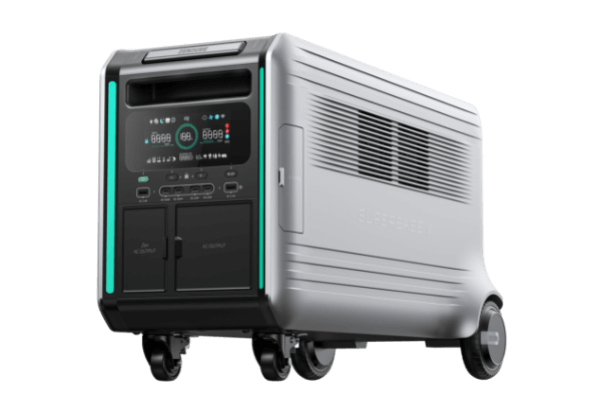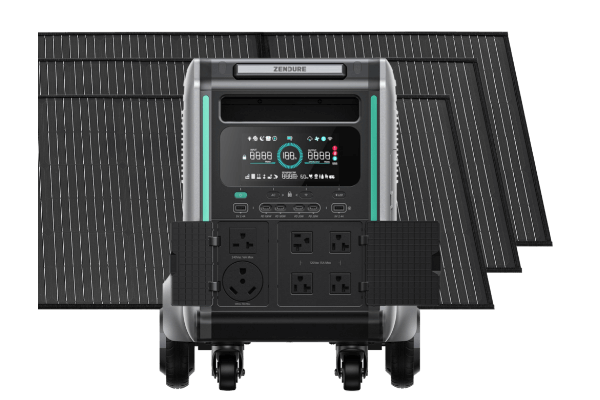Amp to Watt conversion: How to Calculate Watts from Volts and Amps

The basic formula for calculating watts from volts and amps is: Watts = Volts x Amps
However, direct and alternating current require slightly different calculations to determine the watts based on volts and amps.
For example:
- In a DC (direct current) circuit, the formula for calculating watts is simply volts x amps.
- In an AC (alternating current) circuit, the calculation becomes slightly more complex due to factors such as power factor and reactance. For these systems, it's crucial to understand how to handle these variables and the impact they have on the calculation when trying to figure out how many watts in an amp.
This guide seeks to provide a simple and clear method for calculating watts from volts and amps in both DC and AC circuits. Read on to learn more!

What is a Watt?
Before we dive into amp to watt conversion calculations, let's clarify what exactly watts are.
A watt is a unit of measurement used to quantify power and energy transfer in an electrical circuit.
It is named after James Watt, the inventor of the steam engine and one of the pioneers of modern mechanical engineering.
In simple terms, watts represent the amount of work done per unit of time. For example, if you have a lightbulb that uses 40 watts, it means that every second it is on, it consumes 40 joules (a measurement of energy) per second.
What is a Volt?
A volt is the unit of measurement for electrical potential difference, also known as voltage. It represents the amount of energy required to move one coulomb (a unit of electric charge) through an electrical circuit. In other words, it measures the force that pushes electrical current through a conductor.
A simple example of this is a battery. A standard AA alkaline battery has a voltage of 1.5 volts, which means that it provides enough force to push electrical current through a circuit at a rate of 1.5 coulombs per second.
What is an Amp?
An amp (short for ampere) is the unit of measurement for electric current. It represents the flow rate of electric charge in a circuit. In simpler terms, it measures the amount of electrons passing through a given point in an electrical system per second.
To better understand this, think about water flowing through a pipe. The amps would be equivalent to the rate at which water is flowing through the pipe, while the voltage would be the pressure pushing the water through. Just like with water, increasing the amps in an electrical circuit can cause damage or overload.
What is Direct Current?
Direct current (DC) is the type of electrical current that flows in only one direction. This means that the electrons flow from the negative terminal to the positive terminal of a battery or power source, creating a continuous and unidirectional flow of electricity.
Some common sources of DC include batteries, solar cells, and some electronic devices such as laptops and cell phones. It is commonly used for low-power applications, but not for long-distance power transmission due to energy loss during transmission.

What is Alternating Current?
Alternating current (AC) is the type of electrical current that periodically reverses direction. This means that the electrons flow back and forth between the positive and negative terminals of a power source, changing direction at regular intervals.
AC is the type of electricity that is used in most homes and buildings, as well as for long-distance power transmission. This is because it can easily be converted to high voltage for efficient transmission and then reduced to lower voltage for use in homes and electronic devices.

How to Calculate Watts from Volts and Amps in Direct Current
When working with DC, it is important to understand the relationship between amps and watts. Watts (W) is a unit of power that measures the rate at which energy is being used or produced, while amps (A) are a unit of current that measures the rate at which electrons are flowing.
To calculate how many watts in an amp in a DC circuit, you can use Ohm's Law: watts = amps x volts.
This means that if you have a circuit with 2 amps of current and a voltage of 12 volts, the power output would be 24 watts (2 x 12 = 24).
Volts to watts in direct current is a simple conversion as well. You can use Ohm's Law in reverse to find the number of amps in a circuit by dividing watts by volts: volts = watts/amps.
This means that if you have a circuit with 100 watts of power and a voltage of 10 volts, the current flowing through the circuit would be 10 amps (100 / 10 = 10).
How to Calculate Watts from Volts and Amps in Alternating Current
The relationship between amps and watts is slightly different when working with AC circuits. This is because AC constantly changes direction, whereas DC current flows in one constant direction.
In AC circuits, the amount of power being used or produced is measured in volt-amps (VA) instead of just watts. This is because there are two types of currents in an AC circuit – the average current (RMS) and the peak current.
RMS stands for root mean square and represents the effective value of current over a period of time, while peak current refers to the maximum instantaneous value of the alternating current. To accurately measure the power output of an AC circuit, both the RMS and peak currents must be considered.
To find watts in an AC circuit, you can use a slightly modified version of Ohm's Law: watts = volts x amps x power factor.
Power factor is a measurement that takes into account the phase difference between voltage and current in an AC circuit and represents how much of the total energy is being used effectively.
Similarly, to convert volts-amps (VA) to watts in an AC circuit, you would use: watts = VA x power factor.
The power factor in resistive circuits is 1, meaning that all of the energy being used is effectively utilized. However, inductive or capacitive components can cause a phase difference between voltage and current, resulting in a lower power factor and less effective use of energy.
Some examples of inductive or capacitive components that can affect power factors include motors, transformers, and fluorescent lights. To improve the power factor in these types of circuits, devices called power factor correction capacitors can be used.
Zendure SuperBase V: Revolutionizing Power Management
The Zendure SuperBase V stands as a testament to innovation in the realm of power management, particularly relevant to our discussion on wattage, volt-amps, and power factors in AC circuits.

A single SuperBase V unit is capable of delivering up to 3,800W of power. When two units are paired together, they can provide a combined output of up to 7,600W. This substantial power capacity is sufficient to meet the energy demands of an average household – powering essential appliances such as a washer, dryer, heater, refrigerator, and more.
Applications include:
- Emergency backup power for homes and offices during blackouts or natural disasters
- Power source for outdoor activities such as camping, hiking, or boating
- Power supply for remote work sites or events where access to the grid is limited
- Sustainable energy solution for eco-friendly homes and businesses
One of the standout features of the SuperBase V is its intelligent power management system. You can monitor the power consumption of each appliance or device plugged into the SuperBase V via a mobile app. This feature allows users to better understand their energy usage and make more informed decisions on how to optimize their power consumption.
Moreover, the SuperBase V is equipped with a built-in overload protection system that automatically shuts off power if it detects an overload, preventing damage to connected devices and ensuring safety for users.
Whether you're at home or on the go, Zendure SuperBase V has got you covered. Don't let power outages or limited access to grid electricity hold you back – get your hands on the SuperBase V today!
Frequently Asked Questions
How many watts in an amp?
An amp (ampere) is a unit of electric current, while a watt is a unit of power. The relationship between the two depends on the voltage of the circuit in question. For example, at 120V, 1 amp equals approximately 120 watts. However, at higher voltages such as 240V, 1 amp equals approximately 240 watts.
How many watts are in 2000w?
2000 watts is equivalent to 16.67 amps at 120V or 8.33 amps at 240V. This is from the basic formula of watts = volts x amps, where 120V and 240V are standard residential voltages in the US.
To calculate amps to watts, you can use the formula: watts = amps x volts.
How many amps are in 20 amps?
At 120V, 20 amps is equivalent to 2400 watts. At 240V, it would be equivalent to 4800 watts. The wattage will vary depending on the voltage of the circuit.
The basic formula to calculate amps from watts is amps = watts/volts.
How many watts does a home use?
The average American household consumes around 11,000 kilowatt-hours (kWh) of electricity per year, which translates to approximately 1,000 watts on average per hour. This number can vary greatly depending on factors such as the size of the home, number of occupants, and energy efficiency measures in place.
What amp is 1500 watts?
To determine the number of amps in 1500 watts, you need to consider the voltage of the circuit. Using the formula amps = watts / volts:
- At 120V: 1500 watts / 120V = 12.5 amps
- At 240V: 1500 watts / 240V = 6.25 amps
Therefore, 1500 watts is equivalent to 12.5 amps at 120V or 6.25 amps at 240V.
How many watts is a 20 amp 240v circuit?
A 20 amp, 240V circuit has a maximum wattage capacity of 4,800 watts. This is calculated using the formula watts = amps x volts:
- At 120V: 20 amps x 120V = 2,400 watts
- At 240V: 20 amps x 240V = 4,800 watts
It's important to note that even though a circuit may have a certain amperage rating, it should not be overloaded with too many high-wattage devices as this can cause overheating and potentially lead to electrical hazards.
What is 220v in watts?
220V is a common electrical voltage used in many countries, including parts of Europe and Asia. To determine the wattage at 220V, you can use the formula watts = amps x volts:
- At 10 amps: 10 amps x 220V = 2,200 watts
- At 15 amps: 15 amps x 220V = 3,300 watts
- At 20 amps: 20 amps x 220V = 4,400 watts
The actual wattage may vary depending on the specific voltage provided by the circuit.
What appliances consume the most watts?
Some of the most energy-consuming appliances in a household include air conditioners, water heaters, refrigerators, and clothes dryers. These appliances typically consume anywhere from 1000-5000 watts depending on their size and efficiency. Other high-wattage devices could include electric stoves/ovens, space heaters, and laundry machines. It is important to be mindful of these energy-intensive appliances and consider ways to reduce their usage or opt for more energy-efficient options.
How can I reduce my home's energy consumption?
There are many simple steps you can take to reduce your home's energy consumption and lower your electricity bills. Some examples include using LED light bulbs, unplugging electronics when not in use, adjusting thermostat settings, and upgrading to more energy-efficient appliances. Additionally, it is important to regularly maintain and service existing appliances to ensure they are running efficiently. Small changes can add up to significant savings in terms of both energy usage and cost.























Se puede combinar placa solares con los molinos de residencia,tiene que tener mismo watts
How can I measure 220 volts with Ampere gauge…?
Hinterlassen Sie einen Kommentar